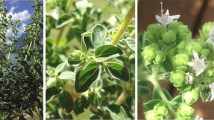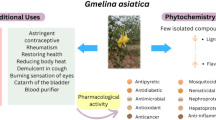Abstract
Breast cancer is the most common cancer worldwide that costs lives of millions of people every year. Plant products with potential anticancer activities have become a vital source of novel agents in treating cancer. Adiantum capillus veneris (ACV) and Pteris Quadriureta (PQ) are such traditional herbs with potential pharmacological properties. In this study, both crude methanol extract and gold nanoparticles of ACV and PQ were tested for their anticancer activities in MCF7 and BT47 cell lines. By using GC–MS, we have identified 23 and 28 bioactive compounds in ACV and PQ respectively. We analysed the effects of ACV and PQ nanoparticles on various proteins involved in cell cycle and apoptosis using western blotting and PCR. With the help of flow cytometry, we measured number of cells undergoing apoptosis. We found that both the crude extract and nanoparticles have anti-proliferative and apoptosis inducing properties against MCF7 and BT47 cell lines. We also performed molecular docking to check whether there were any interactions between proteins involved in apoptosis and cell cycle and bioactive compounds present in the plant extracts. By using docking analysis, we also showed that phytol and eicosapentaenoic acid present in ACV and PQ interact with Bcl2 and cyclin D1. These findings demonstrate that ACV and PQ possess anticancer activities by modulating proteins involved in cell cycle and apoptosis. ACV and PQ that effectively modulate various oncogenic molecules can be used as promising agent for cancer therapy.









Similar content being viewed by others
Abbreviations
- ACV:
-
Adiantum capillus veneris
- PQ:
-
Pteris quadriureta
- GC–MS:
-
Gas chromatography–mass spectrometry
- DMEM:
-
Dulbecco’s modified eagle medium
- PCR:
-
Polymerase chain reaction
- SEM:
-
Scanning electron microscope
- TEM:
-
Transmission electron microscope
- SDS:
-
Sodium dodecyl sulphate
References
Hanahan D, Weinberg RA (2011) Hallmarks of cancer: the next generation. Cell 144(5):646–674
Fouad YA, Aanei C (2017) Revisiting the hallmarks of cancer. Am J Cancer Res 7(5):1016–1036
Carels N, Spinassé LB, Tilli TM, Tuszynski JA (2016) Toward precision medicine of breast cancer. Theor Biol Med Model 13:7
Ferlay J, Soerjomataram I, Dikshit R, Eser S, Mathers C, Rebelo M, Parkin DM, Forman D, Bray F (2015) Cancer incidence and mortality worldwide: sources, methods and major patterns in GLOBOCAN2012. Int J Cancer 136(5):E359–E386
Siegel RL, Miller KD, Jemal A (2018) Cancer statistics, 2018. CA Cancer J Clin 68(1):7–30
Hollander PD, Savage MI, Brown PH (2013) Targeted therapy for breast cancer prevention. Front Oncol 3:250
Ke X, Shen L (2017) Molecular targeted therapy of cancer: the progress and future prospect. Front Lab Med 1(2):69–75
Cazzaniga M, Bonanni B (2012) Breast cancer chemoprevention: old and new approaches. J Biomed Biotechnol. https://doi.org/10.1155/2012/985620
Wang H, Khor TO, Shu L, Su Z, Fuentes F, Lee JH et al (2012) Plants against cancer: a review on natural phytochemicals in preventing and treating cancers and their druggability. Anticancer Agents Med Chem 12(10):1281–1305
Saxena M, Saxena J, Nema R, Singh D, Gupta A (2013) Phytochemistry of medicinal plants. J Pharmacogn Phytochem 1(6):168–182
Pan SY, Zhou SF, Gao SH, Yu ZL, Zhang SF, Tang MK et al (2013) New perspectives on how to discover drugs from herbal medicines: CAM’s outstanding contribution to modern therapeutics. Evid Based Complement Alterant Med 2013:627375
Shaikh R, Pund M, Dawane A, Iliyas S (2014) Evaluation of anticancer, antioxidant, and possible ant-inflammatory properties of selected medicinal plants used in Indian traditional medication. J Tradit Complement Med 4(4):253–257
Shakya AK (2016) Medicinal plants: future source of new drugs. IJHM 4(4):59–64
Zhang YJ, Gan RY, Li S, Zhou Y, Li AN, Xu DP et al (2015) Antioxidant phytochemicals for the prevention and treatment of chronic diseases. Molecules 20(12):21138–21156
Shi J, Votruba AR, Farokhzad OC, Langer R (2010) Nanotechnology in drug delivery and tissue engineering: from discovery to applications. Nano Lett 10(9):3223–3230
Shrivastava S, Dash D (2009) Applying nanotechnology to human health: revolution in biomedical sciences. J Nanotech. https://doi.org/10.1155/2009/184702
Kumar A, Boruah BM, Liang XJ (2011) Gold nanoparticles: promising nanomaterials for the diagnosis of cancer and HIV/AIDS. J Nanomater 2011:17
Nikalje AP (2015) Nanotechnology and its applications in medicine. Med Chem 5:81–89
Bwatanglang IB, Mohammad F, Yusof NA (2014) Role of multifunctional nanomaterials in disease diagnosis and therapy. J Chem 6(11):821–844
Rai M, Ingle AP, Gaikwad S, Padovani FH, Alves M (2016) The role of nanotechnology in control of human diseases: perspective in ocular surface diseases. Crit Rev Biotechnol 36(5):777–787
Sett A, Gadewar M, Sharma P, Deka M, Bora U (2016) Green synthesis of gold nanoparticles using aqueous extract of Dillenia indica. Adv Nat Sci: Nanosci Nanotechnol 7(025005):8
Ahmed S, Ahmad M, Swami BL, Ikram S (2016) A review on plant extract mediated synthesis of silver nanoparticles for antimicrobial applications; a green expertise. J Adv Res 7(1):17–28
Kowshik J, Mishra R, Sophia J, Rautray S, Anbarasu K, Reddy GD, Dixit M, Mahalingam S, Nagini S (2017) Nimbolide upregulates RECK by targeting miR-21 and HIF-1α in cell lines and in a hamster oral carcinogenesis model. Sci Rep 7(1):2045
Sylvester PW (2011) Optimization of the tetrazolium dye (MTT) colorimetric assay for cellular growth and viability. Methods Mol Biol 716:156–168
Levitsky DO, Dembitsky VM (2015) Anti-breast cancer agents derived from plants. Nat Prod Bioprospect 5(1):1–16
Afshar AS, Nematpour FS, Meshkani M, Khaf A (2017) Growth inhibition of human breast cancer cells and down-regulation of ODC1 and ADA genes by Nepeta binaloudensis. Revista Brasileira de Farmacognosia 27:84–90
Lin M, Lin J, Wei L, Xu W, Hong Z, Cai Q et al (2012) Hedyotis diffusa Willd extract inhibits HT-29 cell proliferation via cell cycle arrest. Exp Ther Med 4(2):307–310
Cai Q, Lin J, Wei L, Zhang L, Wang L, Zhan Y et al (2012) Hedyotis diffusa Willd inhibits colorectal cancer growth in Vivo via inhibition of STAT3 signaling pathway. Int J Mol Sci 13(5):6117–6128
Casuga FP, Castillo AL, Corpuz MJAT (2016) Bioactive compounds and cytotoxicity of ethyl acetate extract from Broussonetia luzonica (Moraceae) blanco leaves against hepatocellular carcinoma (Hepg2) cell lines. PHCOG J 8(5):497–501
Author information
Authors and Affiliations
Corresponding author
Ethics declarations
Conflict of interest
The authors state that they have no conflict of interest.
Rights and permissions
About this article
Cite this article
Rautray, S., Panikar, S., Amutha, T. et al. Anticancer activity of Adiantum capillus veneris and Pteris quadriureta L. in human breast cancer cell lines. Mol Biol Rep 45, 1897–1911 (2018). https://doi.org/10.1007/s11033-018-4337-y
Received:
Accepted:
Published:
Issue Date:
DOI: https://doi.org/10.1007/s11033-018-4337-y




